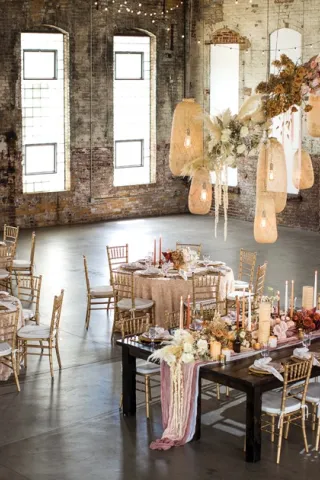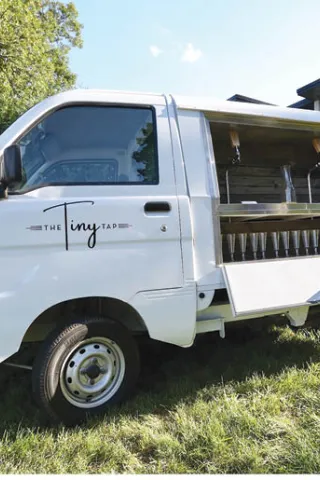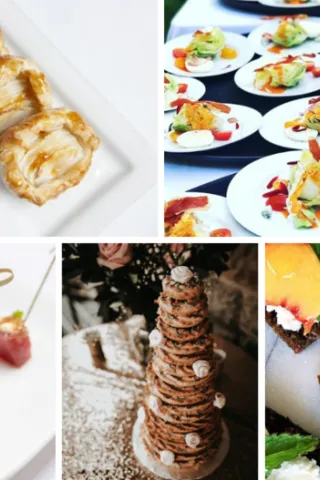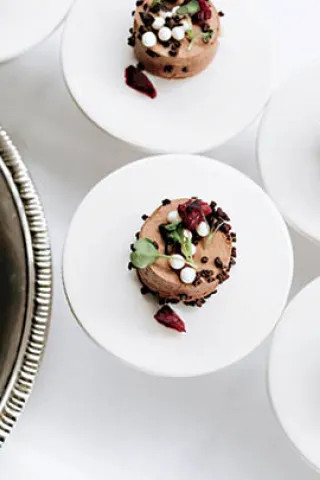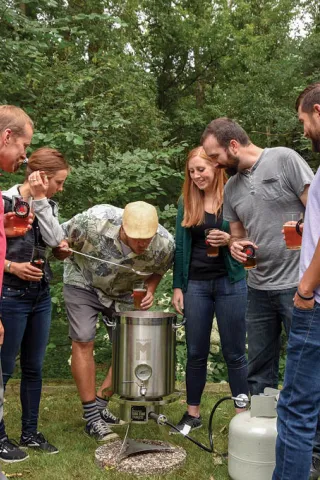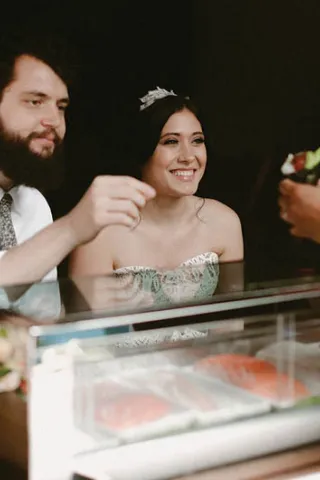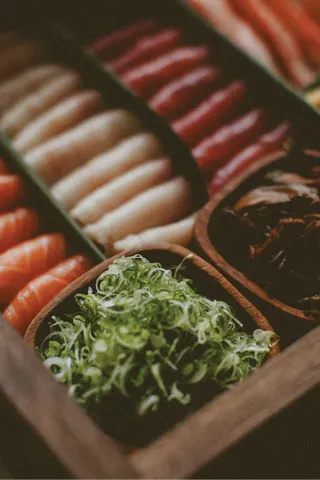We’ve all got a horror story about a wedding we attended where things didn’t quite go our way. Maybe it was the one where the bride and groom’s seating chart stuck you next to an obnoxious uncle who talked your ear off all night. Or was it the time you arrived at the reception absolutely famished only to discover an hour-long buffet line? No, wait—it was the time you had to endure a two-hour plated meal featuring a desiccated hunk of chicken breast, and by the time it was over, you never got to have a word with the bride and groom.
All of the above are possible results of the traditional wedding-meal format. Sit-down dinners often mean seating charts probably won’t please everyone. Guests are obliged to stay in one spot for long periods whether they’re hungry or not, and the set menus may leave vegetarians or anyone with an aversion to beef or chicken feeling slighted. On the other hand, go with one long buffet line and your guests may spend more time queuing up than mingling and enjoying themselves.
To avoid these potential drawbacks, many wedding couples are doing away with the traditional wedding meal and opting for food stations, a concept best described as a group of mini-buffets placed throughout the reception area, each offering a unique kind of fare and often manned by an actual chef.
When Jeremy Johnson and Julie Peterson agreed on St. Paul’s James J. Hill Library for their Valentine’s Day wedding, they went with more casual food stations to contrast the formality of the venue. “We wanted to take out any of the impediments to people doing what they wanted to do,” says Johnson.
Since the wedding was scheduled for later in the evening, Johnson and his bride-to-be knew that guests probably wouldn’t be interested in sitting down to a full meal. The food station concept is a popular choice for evening weddings, especially Friday-night receptions, according to Nicole Aronson, an event consultant for Mintáhoe Hospitality Group, which catered Johnson and Peterson’s reception.
Johnson was pleased with the stations that Mintáhoe put together, which included a grilled Portobello mushroom station, salmon with a variety of cheeses and salad greens, and marinated beef tenderloin. He says the mashed potato martini bar drew the most response by far, with mashed potatoes served in a martini glass with a variety of toppings like mushroom ragout or velvety poulet. As for the overall dining experience, he says guests appreciated being able to eat whenever they wanted. The food was ready when everyone arrived and there was never a line.
Mike Sneen, executive catering chef at D’Amico Catering, had a bit of a dilemma on his hands when he discovered that his wedding date fell on Super Bowl Sunday; food stations were an obvious choice. One of the rooms at the Calhoun Beach Club in Minneapolis was transformed into a makeshift Super Bowl party, with a full bar and large TVs so guests could keep up with the game if they didn’t want to rush home too quickly.
Meanwhile, five food stations were positioned in the solarium, with a completely gluten-free menu to accommodate a guest’s wheat allergy. The masa station offered seafood enchiladas, tamales and build-your-own tacos. An Asian station included sushi, pad Thai, meatballs and dumplings, with the noodles served in Chinese to-go boxes with chopsticks. Sneen says the boxes were a fun novelty, but any kind of serving ware can be used to suit the preferences of the bride and groom, from bread-and-butter plates to dinner plates, ornate serving pieces to disposable plates.
 Leaving food stations open adds flexibility so guests can munch when they feel like it, with the opportunity to walk around, drink and spark up conversation in between plates. Sneen intended for his reception food to be set out over three hours, but found guests were still enjoying the food at 6 p.m., so he extended the time.
Leaving food stations open adds flexibility so guests can munch when they feel like it, with the opportunity to walk around, drink and spark up conversation in between plates. Sneen intended for his reception food to be set out over three hours, but found guests were still enjoying the food at 6 p.m., so he extended the time.
Overall, Sneen loved that his guests weren’t locked into sitting with the same people for two or three hours. “There was a lot of movement in the room. As the bride and groom, we were able to talk to everyone for as much time as we wanted to,” he says.
When Lynn Timm’s daughter, Jessica, decided on Minneapolis’ Nicollet Island Pavilion for her June wedding, only Friday dates were available. She wanted a small, intimate evening affair and the food station concept had an immediate appeal. “We wanted people to be able to eat, drink and mingle with other guests and enjoy the beautiful surroundings of the pavilion that evening,” says Timm.
The bride, groom and mother of the bride created a blend of favorite dishes by handpicking items from their tasting session based off Mintáhoe’s menu. Timm’s own favorite was the pistachio-crusted salmon, but she says the meat-based stations were the most popular. Only the vegetable and cheese stations had anything left over at the end of the evening.
Timm says that wedding traditions like speeches, cake-cutting and a bouquet toss can still easily be incorporated with food stations. At her daughter’s wedding, the fathers of the bride and groom gave a champagne toast immediately after the ceremony and grand march, which was in the same venue.
 Since tables were not adorned with complete dinner settings, floral arrangements and colorful linens livened them up. Many ways exist to create excitement at the food stations: Chefs cooking the food on site encourage guests to interact and ask questions, and linens and arrangements can complement the theme of the cuisine. Jenni Ellson, a Mintáhoe event consultant, describes how Mintáhoe’s “East Meets West” station adds special appeal at many weddings, with a chef grilling different kinds of seasoned burgers using fiery red griddles, and bamboo display pieces and polished chrome accents to enhance the station’s appearance.
Since tables were not adorned with complete dinner settings, floral arrangements and colorful linens livened them up. Many ways exist to create excitement at the food stations: Chefs cooking the food on site encourage guests to interact and ask questions, and linens and arrangements can complement the theme of the cuisine. Jenni Ellson, a Mintáhoe event consultant, describes how Mintáhoe’s “East Meets West” station adds special appeal at many weddings, with a chef grilling different kinds of seasoned burgers using fiery red griddles, and bamboo display pieces and polished chrome accents to enhance the station’s appearance.
Some couples also choose to include high-top tables for guests who might want to eat standing up. Charlene Otto, corporate director of catering at Lancer Catering, the exclusive caterer for the Minnesota Zoo in Apple Valley, says that different types of tables and open layouts make things easy so that guests can try many foods at different times with breaks between each tasting.
When considering food stations, couples should size up both the venue and the guest list to ensure that the room won’t be cramped, since the stations will use more space. Event consultants can help determine the optimal setup, but popular layouts put stations in the corners and tables in the center of the room, which draws people out to explore the room and cross paths with a variety of guests.
FOOD STATION BRAINSTORMING
Classic American: Roasted marinated vegetables, bacon-wrapped scallops, wild mushroom gratin
Latin: Seafood enchiladas, tamales, build-your-own tacos
Asian: Dumplings, coconut shrimp, pad Thai, sushi
East Meets West: Grilled sirloin, lamb, turkey, black bean, falafel or crab mini-burgers, assorted cheeses, and accompaniments like dilled yogurt sauce or sundried tomato mustard
Euro-pasta: Assortment of pastas, add-ins like shiitake mushrooms, julienne peppers, shrimp or Italian sausage, and a choice of sauces
Appletini Desserts: Sautéed apples, caramel, whipped cream, cocoa powder or cinnamon, served in a plastic martini glass

